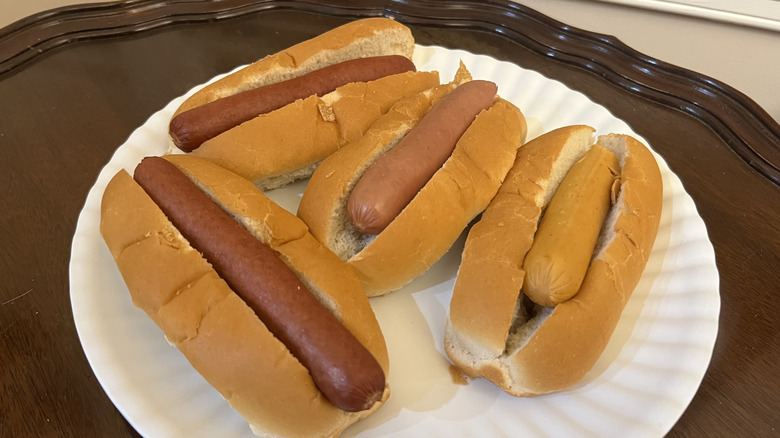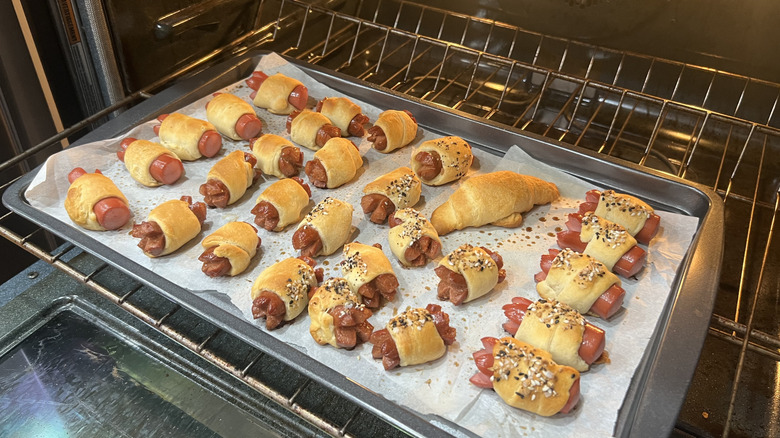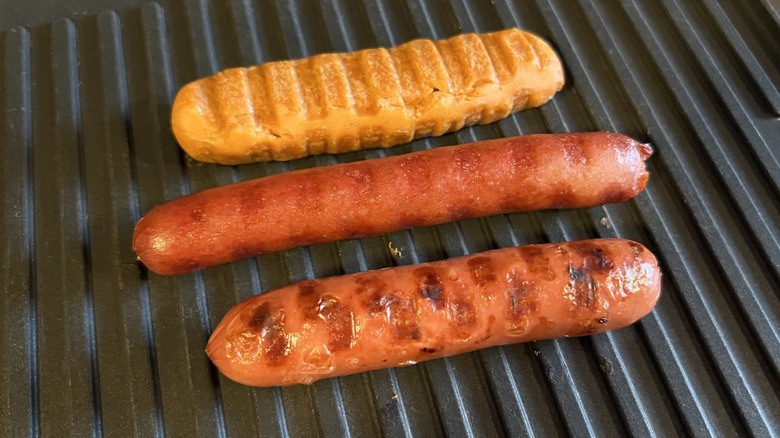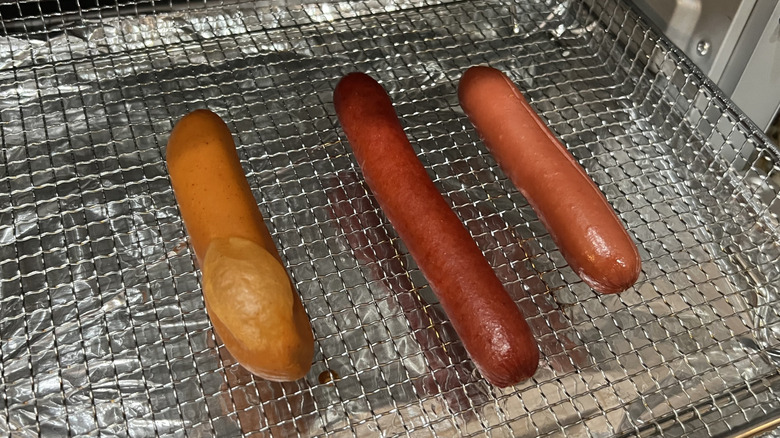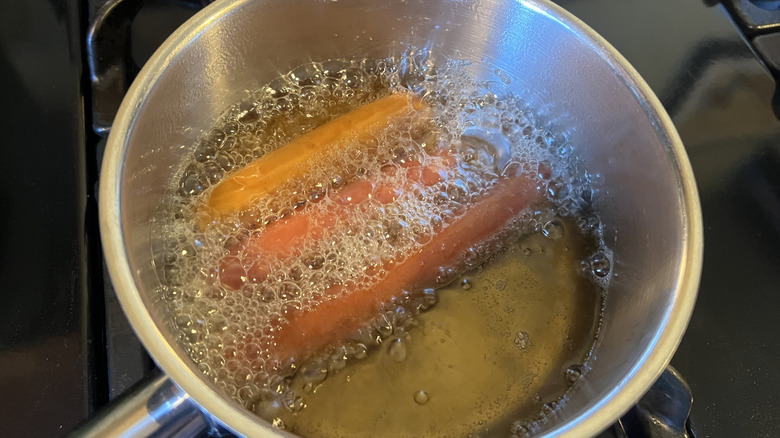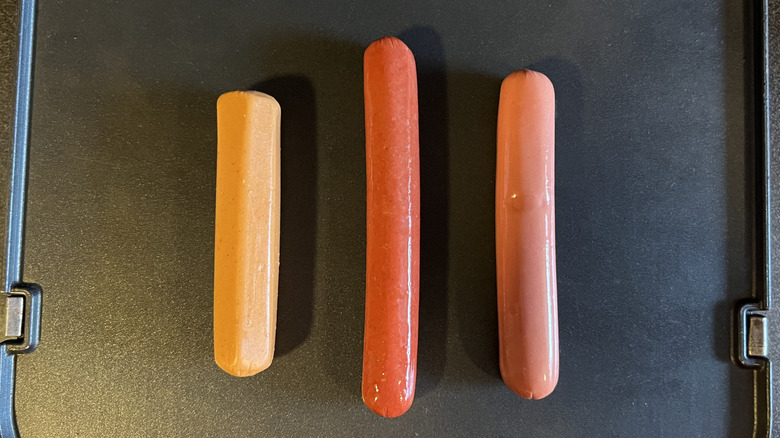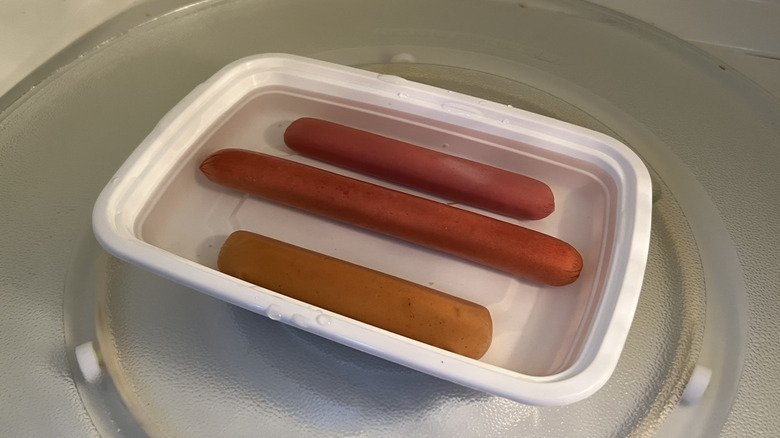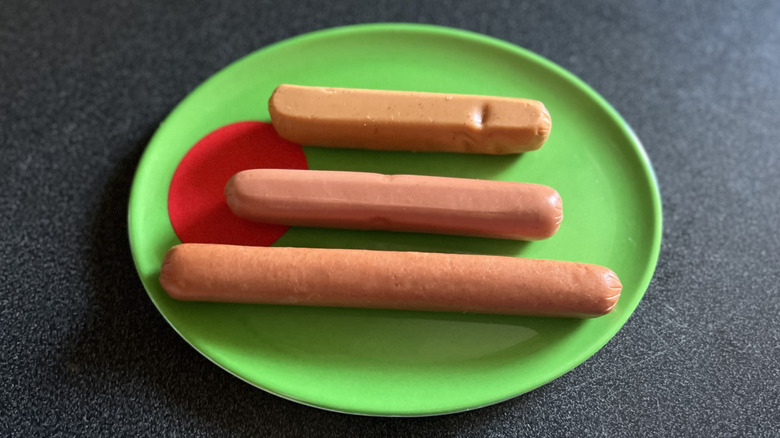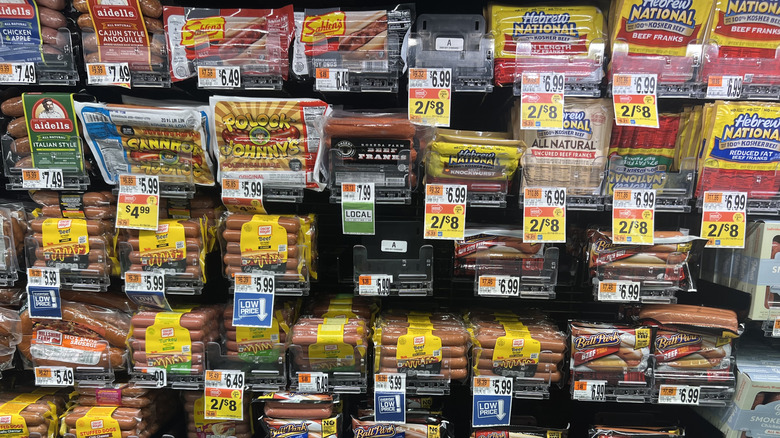The 8 Best And Worst Ways To Cook Hot Dogs
The hot dog's origins got cooking in Europe, and those in Frankfurt, Germany, and Vienna (locally known as "Wien"), Austria, both lay claim to introducing the world to the frankfurter and the wiener, which are different. When immigrants from these areas settled in America in the 19th century, the encased meat's popularity started to boil over. Thanks to Charles Feltman, he brought buns into the eating equation in 1867, so Coney Island beachgoers could enjoy them without a plate. The name "hot dogs" entered the lexicon in 1901 when newspaper cartoonist Tad Dorgan couldn't spell "dachshund sandwiches" and went with his own idea.
For the rest of the 20th century, and still to this day, the hot dog has become an all-American staple, still best enjoyed at the ballpark, a movie theater, or a barbecue cookout as well as in the comfort of one's own domicile. There are many ways to cook hot dogs, but some are truly better than others. The Takeout grabbed a plethora of packs of all-beef, turkey, and plant-based dogs and tried out eight methods of cooking to see which were the best — and which were the worst. Some of the results were surprising, many were delicious, and others I'd like to simply never speak of again. Enjoy!
Best: Pigs in a Blanket in the oven
Pigs in a blanket have the most prep time, as you need to slice the dogs into pieces and individually wrap them with dough. I recommend the canned crescent rolls from Pillsbury. If you want to spice things up further before baking, shake a dash of everything but the bagel seasoning on the dough. Another way to spiffy up their appearance is by scoring the bottom of the dogs to give these piggies "legs."
The cooking is very straightforward, as you lay the pigs on a tray and pop them into the oven to bake for 12-15 minutes at 375 degrees Fahrenheit. You can tell when they're done based on the browning of the dough. When ready, they'll be piping hot, and it will be super-hard to resist eating them right away. I myself cannot ever resist! The dough is now a tad flaky but soft and delicious. As for the hot dogs, the oven method ensures they will cook evenly and have a nice lean crunchiness to them as well as a welcoming smoky taste.
Pigs in a blanket are the most crowd-pleasing way to eat hot dogs, as both the young and the old can agree on their deliciousness. They're perfect hors d'oeuvres to serve for the big game or even a kid's birthday party. With their small stature, they also are fun to dip in an array of ideal hot dog condiments. Also, if you used tin foil or parchment paper on your baking tray during cooking, cleanup is a cinch. This is easily the best and most recommended way to enjoy hot dogs.
Worst: Boiling on a stovetop
One of the most common and basic ways to cook hot dogs is boiling them in a saucepan over a gas or electric stovetop. Make sure your water level far exceeds the height of your dogs, although no amount of water could keep these plant-based dogs down, as they kept floating up during the process. Flame level and cooking time will vary per stove, but an even medium level heat and 10-12 minutes will get you edible hot dogs.
Underwater, the dogs looked like someone's fingers were soaking for a manicure and worse, reminded me too much of the dirty dogs one can order up from a cart in Times Square. Once they're done, they require a paper towel to dry off. The dogs continue to have a wet, shiny look to them, even long after they've left their bath. One positive note I will say about the boiling method is that you'll get a consistently cooked hot dog, from one rounded end to the other.
Eating these dogs instantly proved that this method does no real service to them. They are lumpy and chewy, which is not what anyone is looking for with each bite. Sure, the flavor of the meat is retained, but if you have any interest in enjoying the skin, that idea gets thrown out the window. The casing is a non-factor in the final taste, as the water has neutralized its purpose for being. Pass.
Best: Grilling
Besides apple pie, one of the more iconic Americana foods is a grilled hot dog. Just the very thought of one conjures up sunny times in one's backyard, celebrating with family and friends on Memorial Day, the Fourth of July, or Labor Day. This method works best with an outdoor gas grill, but even indoor grills can deliver similarly tasty results year-round, especially for those who live in an apartment.
Visually, nothing tops the grill cooking method for hot dogs. All those charred grill marks are a badge of honor for the dogs, and those earned stripes add a fun texture when gobbling up the final product. The outdoor grill requires flipping the hot dogs to even out the marks, but a dual-sided indoor grill can press the dog from two sides to save time. When I pressed down on my dogs, they actually let out an audible steamed scream.
After they quieted down, the dogs had a nice crisp exterior to them and a smoky, full flavor within. That was certainly true for the beef and turkey dogs. As for the plant-based ones, the grill certainly helped to sell their look and brought a bit of crispness to the skin, but grilling couldn't save the interior from tasting like mush. This method requires the most cleanup, as the dogs sometimes stick to the grill, leaving char bits behind. Still, sometimes a little extra effort goes a long way.
Worst: Air fryer
Air fryers have been quite the modern marvel, making quick work of cooking with endless delicious results, including the likes of air fried Twinkies. Because deep-frying hot dogs comes with greasy baggage, one might think an air fryer would achieve similar results with less of a mess.
I laid beef, turkey, and plant-based dogs on the meshed metal fry basket, set the temperature for 400 degrees, and monitored them for the next 6 minutes. While the dogs physically had a nice color to them, the results looked like they had just been boiled in water. Well, that wasn't exactly the case for the plant-based one, whose casing couldn't handle the heat and formed a bubble that resembled a toe blister. Yikes! The other dogs' casings had a little bit more crispness to them than the boiling method, but the air fryer still created a separated looseness. If you're not really into the casing, your best bet may be to peel it off from the interior meat. Overall, the dogs came out hot, a little dry on the outside, and a bit too mushy on the inside to make this a worthy way to cook them.
Best: Fried
For eons, humankind has enjoyed its foods fried. While we all dream of having a deep fryer in our home kitchen, one can still get pretty close to the cooking experience with a pot or pan filled with oil on a stovetop. This method for cooking hot dogs is a recipe for messiness and for possibly getting burned from the popping grease. I thought I'd have to turn the dogs over often to get them evenly cooked, but being surrounded in the oil ended up doing all the work for me. The dogs were done in a matter of minutes.
Out of all of the cooking methods, these fried hot dogs resulted in the most crispness of the skin and the richest browns of color. From there, it's love at first bite for both the beef and turkey dogs, as the frying created the best combination of texture and flavor. The lightly fried skin had an excellent crispness to it that one's teeth will enjoy gnawing on. Like with the grill, the interior meat is both smoky and juicy. The frying certainly helped the plant-based one to be as good as it could possibly be, but in the end, frying couldn't make it edible. The only problem with this method is working with oil. If you avoid getting burned, in the end you still have to deal with disposing of the oil. If you're only cooking a few dogs, it may not be worth all the greasy effort. However, for some, "Grease" remains the word.
Worst: Griddle
A flat top grill is a common sight at restaurants to cook up hot dogs and an option not often taken at home. A flat griddle pan or griddle maker machine works wonders for pancakes at home, so hot dogs should be able to find similar success, right?
Like with a double-sided indoor grill, hot dogs can be cooked quicker with a double-sided flat top griddle by pressing down on them. The flat pan method takes a little more time, but the results are the same. Where a grill provides patterned marks to give the dog both a fun appearance and welcome texture, the griddle imprints full-bodied char marks on the hot dogs. The griddle can also push the skin to bubble up a bit. Neither helps to sell this method to an eater's eyes. Despite their cooked look, the dogs almost tasted uncooked. The interior meat was juicy, but the flavor it created didn't hit the required mark. The one positive is that griddles are super easy to clean, making your next breakfast a lot brighter when it's time to cook up something much better –- fluffy pancakes.
Best: Microwave
The microwave has always been associated with a quick and easy way to heat foods but not always the most recommended way to make that food tasty. In the past, hot dogs were simply put on a plate and nuked up. The key to microwaving hot dogs these days calls for either wrapping them in a wet paper towel or the method I went with — placing them in a covered, microwave-safe dish with ½ cup of water. Heat them for at least 90 seconds.
Seeing my three dogs sitting in the water reminded me of boiling them on a stove, and the results would soon tell if they were on par. In no time, the dogs were done, and a beautiful smell emanated from the microwave. It was perhaps the one method where the smell was more omnipresent than with the others. The microwave gave the beef and turkey dogs a nice reddish-brown cooking tan, although somehow it couldn't change the skin color of the plant-based one whatsoever.
Once I toweled them off from their water tray, I took a nibble of each. I couldn't believe the results, as the meat ones had a great juiciness to them, and the skin held up pretty well. They were somehow better cooked this way than they were by boiling them, so why waste the extra time? The microwave does allow the dogs to come out barking hot, but be warned, the heat is fleeting, and these will quickly turn cold if not devoured right away.
Worst: Uncooked
If you are okay to negate the "hot" part of "hot dogs," eating them as is I guess is an option. I'm not sure anyone would need to do this, but some circumstances may warrant it, like loss of electricity and gas or lack thereof in the wild. By nature, hot dogs are already fully cooked, and all other methods are just heating them up. Alas, it is highly recommended for health reasons to not eat them "raw." The U.S. Department of Agriculture's website notes, "those at increased risk of foodborne illness should reheat hot dogs and luncheon meat until steaming hot before eating, due to the threat of listeriosis."
For this test, I removed the dogs from the refrigerator and let them sit out for an hour to reach room temperature. Still, they remained pretty chilled after all that time. I started with the beef one. It had a firm chewiness to it, like you're almost eating something between a less rigid Slim Jim and a soft salami. Eating the turkey one actually tasted more like turkey than the beefy hot dog it's trying to pass itself off as. As there is no browning of the turkey dog's casing in this method, you just have to get over the fact that color will remain an unappealing yellowish-white color. The plant-based dog had a similar chewy consistency to the others, but the innards fell apart the moment my teeth met them, making it nearly impossible to enjoy.
Methodology
To find the best and not-so-best ways to cook hot dogs, I thought it would be fair to include the main types of dogs that various people enjoy. I picked all-beef hot dogs made by Hebrew National, turkey ones made by Oscar Mayer, and plant-based vegan smart dogs by LightLife. They were all purchased by me from a single grocery store. For the purposes of this expanded cooking and taste test, all the dogs were stored in a refrigerator until it was time to cook them. The materials used to conduct this test were a gas-powered stovetop, a microwave, a standard oven, a multi-purpose air fryer, and a 5-in-1 griddler, which also included an indoor grilling option.
Since there were eight methods to try, the cooking was conducted over four different sessions in no particular order. While there are many approved ways to prepare hot dogs before cooking them, like making a butterfly cut or spiralizing them, I thought the fairest way to conduct these tests equally was to cook them as is.
The cooking was handled by myself, and others whose ages ranged from 5 to 82 taste-tested the results with me, providing their opinions as well. While I took their notes into consideration, ultimately, I decided which methods were truly best and which ones were not so great. The criteria included flavor, texture, smell, ease of cooking, messiness/cleanup, time, and overall deliciousness. Now that the test is complete, it's time to move onto bigger quandaries, like is a hot dog a sandwich?
